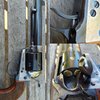Driftwood Johnson
Member
I am well aware of that, however, in the parlance of modern handgunning, the Bisley name is pretty much owned by Ruger, particularly in the custom revolver world. It is Ruger's interpretation of the Bisley and frankly it was a better execution IMHO with regards to controlling recoil. I have shot the Number 5 and it is not nearly as good as the Bisley when real recoil is on the table -- again, IMHO.
I hope you realize I was just funnin' you when I said that was not a Bisley.
However, I will quibble with you about who 'owns' the name Bisley.
As far as I know, it is not trademarked by anybody. As such, I consider Ruger's interpretation of the Bisley grip shape to be exactly that, an interpretation.
Of course, the original Bisley grip was not meant to contend with massive recoil, it was meant to be a target grip, hence the name. It was introduced at the National Target Matches at the Bisley range near London, UK in 1894


